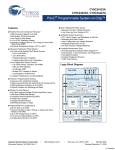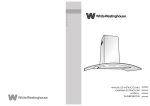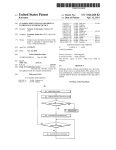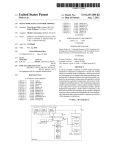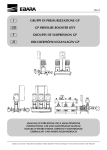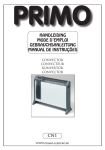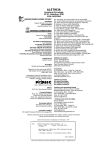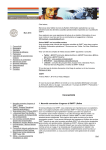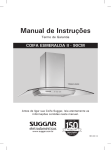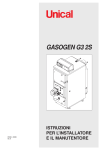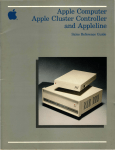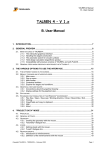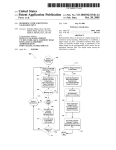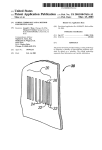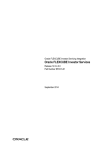Download Method of programming the default cable interface software in an
Transcript
USOO8868802B2 (12) United States Patent (10) Patent N0.: Barten (54) (45) Date of Patent: Oct. 21, 2014 METHOD ()1? PROGRAMMING THE 6,612,495 B2 * DEFAULT CABLE INTERFACE SOFTWARE 6,707,581 B1 * 3/2004 Browning IN AN INDICIA READING DEVICE 6,719,202 B1 * 4/2004 Kawai 6161. 6,877,663 B2* 4/2005 7,044,383 B2 * 7,104,456 B2 5/2006 Zhu et a1. ............... .. 235/462.46 9/2006 Parker et 31. (75) Inventor: (73) Assignee. Hand Held Products, Inc., Fort M111, ~ 6,619,549 B2 * Henri Barten, Limburg (BE) . - 7,389,918 B2 SC (Us) Notice: Subject to any disclaimer, the term of this 2007/0228137 A1 2008/0228773 A1* Y Y - Kelly et al. 2008/0307197 A1 11/2010 """ n 358/473 .. 235/462.13 .... .. 235/462.15 Wike, Jr. et a1. 10/2009 Rathus 6161. 2008/0230607 A1 - 6/2008 Zhu et a1. ............... .. 235/462.45 7,600,691 B2 U S C 15403) b 176 da S ~ 9/2003 10/2008 Bhella et al‘ patent is extended or adjusted under 35 - 9/2003 Reddersen et a1. .... .. 235/462.15 7,438,217 B2 7,837,111 B2 * (*) US 8,868,802 B2 Yang et a1. ............. .. 235/462.13 10/2007 Bhella et a1. 9/2008 Stewart et a1. ................ .. 707/10 9/2008 Etten 12/2008 2009/0048870 A1* 2/2009 Calvm 6161. Godshallet al. ................ .. 705/3 (21) App1.No.: 12/578,635 2009/0078773 A1 3/2009 Carlson 6161. 2009/0108067 A1* 4/2009 (22) Filed; 2009/0200380 A1 8/2009 Longacre, Jr. et a1. 2009/0237221 A1 9/2009 Battles et a1. Oct, 14, 2009 (65) Prior Publication Data US 2011/0087810 A1 FOREIGN PATENT DOCUMENTS Apr. 14, 2011 WO (51) Roquemore ........... .. 235/462.15 Int. Cl. * 6an 13/12 (2006.01) G06K 7/10 G06K 7/00 (200601) (200601) 2009064759 - 5/2009 - med by exammer Primary Examiner * Titus Wong (74) Attorney, Agent, or Firm * Additon, Higgins & (52) U-s- Cl- Pendleton, P.A. CPC ........ .. G06K 7/0004 (2013.01); G06K 7/10881 (2013.01); G06K 2207/1017 (2013.01) (58) (57) ABSTRACT USPC ......... .... ...... ... .................. .. 710/62; 236/462.14 An indicia reading apparatus includes an interconnect cable Fleld 0f Classmeatlen search CPC G06F 17/00; G06K 7/10 and an indicia reading device. The indicia reading device is con?gured so that, if the indicia reader device is not con?g See apphcatlon .... .............................. ?le fOr COmP16Ie.. seafCh hISIOI‘y- ured does to notany contain interconnect one of a cable plurality andof detects speci?ed an indicia sequences of _ References Clted data elements that the indicia reading device Will recognize and use to con?gure itself to operate With the interconnect cable, the indicia reading device Will indicate to the user of the indicia reading device that the indicia reading device needs to be con?gured to operate With the interconnect cable. (56) U.S. PATENT DOCUMENTS 5,424,524 A * 6/1995 6,293,467 B1 9/2001 Reddersen et a1. Ruppert et a1. ............... .. 705/17 6,415,978 B1* 7/2002 17 Claims, 12 Drawing Sheets McAllister ............. .. 235/46201 Power-Up Scanner ‘ 230 234 232 lm Default Variable F llled'? Indicate To User That Scanner is 7 N01 Reaw For 236 Scanning 238 Fill the De1ault lnte?ace Variable y 240 Idle, Ready to Scan US. Patent 0a. 21, 2014 Sheet 1 0112 US 8,868,802 B2 FIG. 1 136 130 134 1 2x“ 128 118 122 12 126 120 US. Patent Oct. 21, 2014 US 8,868,802 B2 Sheet 2 0f 12 EoL"cmos>Ez2Jm=E §mQ58|?r. "rmungloLwHmvcnmoVFw:;O g.m gLeomwAowIi Y m_g6$3E:0w.25u869120w oa2nb:B@o2EA895:muI0EN?2 49?an5owm@/egvac:2ohme6w1 ma\,/J :MHa- AHlr.Lv 23ELz98w"0Ua254|Alo.?n0swao 2a9":2&538.50“25-wA!Al0w 9<unAl"809>%5:3I2E$v:w< ._o?z1"wm n_ -.E"FOWL50m1_6 wm"o?“mQE6otBw>$E“im:6a?wnmeE " “E gH / n#9 mm? __ mm:P "“oweI" :[ _ \gwt620a__Em: o 6&3HnBEE » 1W.9L. US. Patent Oct. 21, 2014 US 8,868,802 B2 Sheet 3 0f 12 502m mow wow wow 8N war 2 l m“au/m‘8a6! m o w l NR) 2:8Em a N: vmr 469. Fon SNmm:02 @52\8r1 US. Patent Oct. 21, 2014 US 8,868,802 B2 Sheet 4 0f 12 mFOEm mOwMG E wow wow mom mm? .520 .QEmm :1 w>ao Fz4_<QOJ com09‘ Hwoz mow KMszA\m@w US. Patent Oct. 21, 2014 US 8,868,802 B2 Sheet 5 0f 12 50 m mOw o wow wow mom .2 8 I. mama .2$09 OONom w Pon mewo $5\@2 / v2 mm? US. Patent Oct. 21, 2014 US 8,868,802 B2 Sheet 6 0f 12 502m mow u Now 2 .Gm0_n_ w 25 wo._>w_>Oo<|Ew6 RN 8N 0 N: F x“ #09. mow l Go: w?8w.2: I mQHa<moa> 2 152\@2% US. Patent 0a. 21, 2014 Sheet 7 0f 12 US 8,868,802 B2 Power-Up Scanner 230 Begin Boot Sequence 234 Indicate To User Has an Interface That Scanner '5 FDl lndicia Default Variable NOt Ready For Been Filled? Norm?| Scanning Scanned? 236 YES 238 Fill the Default interface Variable 240 Load Interface Default and Continue Boot Fl G I 4A Sequence ldle‘ Ready to Scan US. Patent 0a. 21, 2014 Sheet 8 0f 12 US 8,868,802 B2 Power-Up Scanner - 234 Indicate To User That Scanner is ——-} Not Ready For Norm-8| Scannlng Begin Boot Sequence Has all 236 FDI Ind|0|a Been Scanned? 242 Boot to a First 238 Con?guration Fill the Default Interface Variable 244 Load Interface Default Boot to a Second Con?guration Idle, Ready to Scan FIG. 4B US. Patent 0a. 21, 2014 Sheet 9 0f 12 US 8,868,802 B2 FIG.5 US. Patent 0a. 21, 2014 Sheet 10 0f 12 US 8,868,802 B2 Standard USB-Cable Cable PN# 42206161-01E i l i i il li lili lilili l lil i lil lil l lil l il lililil ili il i IMPORTANT NOTICE Please be notified when you do use your bar code reader for the first time it will beep and flash the Ieds to let you know its default interface requires to be configured To set the default interface to match the cable in this bag, scan the bar code below Set Default Interface to USB PC Ke board 254 For more detailed instructions refer to the First Time Usage section in the user manual or Quick Start Guide FIG. 6 / 252 US. Patent 0a. 21, 2014 Sheet 11 0112 US 8,868,802 B2 FIG.7 US. Patent 0a. 21, 2014 Sheet 12 0112 US 8,868,802 B2 Standard USB-Cable Cable PN# 42206161-01E lil ilililil l il i il li l lili lil lili ili il i l ilil il l i l IMPORTANT NOTICE Please be notified when you do use your bar code reader for the first time it will beep and ?ash the leds to let you know its default interface requires to be configured To set the default interface to match the cable in this bag, read the RFID tag below Set Default Interface to USB PC Keyboard / 272 For more detailed instructions refer to the First Time Usage section in the user manual or Quick Start Guide FIG. 8 / 270 US 8,868,802 B2 1 2 METHOD OF PROGRAMMING THE DEFAULT CABLE INTERFACE SOFTWARE IN AN INDICIA READING DEVICE cable if the indicia reader device detects an indicia which does not contain a speci?ed sequence of data elements that the FIELD OF THE INVENTION in the interconnect cable with the speci?ed sequence of bar data elements. In still another form, the invention includes a method for indicia reading device will recognize and con?gure itself to operate with the interconnect cable, and an indicia with, on or This invention relates to indicia reading devices, and more particularly to a method of programming the default cable interface software in an indicia reading device. requiring a user of an indicia reader device to initially con ?gure the indicia reader device for operating with an inter connect cable. The method comprises the steps of con?guring BACKGROUND OF THE INVENTION the indicia reader device so that if the indicia reader device detects an indicia which does not contain one of a plurality of Indicia reading devices (also referred to as optical indicia speci?ed sequences of data elements that the indicia reading readers, scanners, RFID readers, etc.) typically read indicia data represented by printed indicia or data carrier indicia, (also referred to as symbols, symbology, bar codes, RFID device will recognize and use to con?gure itself to operate with the interconnect cable, the indicia reading device will indicate to the user of the indicia reading device that the indicia reading device needs to be con?gured to operate with the interconnect cable, and providing an indicia with an inter connect cable which includes one of the plurality of speci?ed sequences of data elements which is applicable to the inter tags, etc.) For instance one type of a symbol is an array of rectangular bars and spaces that are arranged in a speci?c way to represent elements of data in machine readable form. Another type of symbol is encoded as data in an RFID tag. Optical indicia reading devices typically transmit light onto a symbol and receive light scattered and/or re?ected back from a bar code symbol. The received light is interpreted by an image processor to extract the data represented by the sym bol. Laser indicia reading devices typically utilize transmitted laser light. RFID readers typically activate RFID tags which 20 connect cable. BRIEF DESCRIPTION OF THE DRAWINGS 25 transmit data symbols to the RFID readers. One-dimensional (1D) optical bar code readers are char conjunction with the accompanying drawings, in which: acterized by reading data that is encoded along a single axis, in the widths of bars and spaces, so that such symbols can be The aforementioned and other features, characteristics, advantages, and the invention in general will be better under stood from the following more detailed description taken in 30 FIG. 1 is a partial cutaway view of an optical indicia reader in accordance with at least one embodiment of the present read from a single scan along that axis, provided that the invention; symbol is imaged with a suf?ciently high resolution along FIG. 2 is a block diagram of the optical indicia reader of FIG. 1; FIGS. 3A, 3B, 3C, and 3D are block diagrams of typical data processing systems with which the reading device shown that axis. In order to allow the encoding of larger amounts of data in a single bar code symbol, a number of 1D stacked bar code 35 symbologies have been developed which partition encoded data into multiple rows, each including a respective lD bar in FIG. 1 may be used; FIGS. 4A and 4B are ?ow charts of alternate procedures for code pattern, all or most all of which must be scanned and initially con?guring the reading device shown in FIG. 1; decoded, then linked together to form a complete message. Scanning still requires relatively higher resolution in one FIG. 5 is a perspective view on an interconnect cable in a 40 device shown in FIG. 1; FIG. 6 is an enlarged view of the label shown in FIG. 5; dimension only, but multiple linear scans are needed to read the whole symbol. A class of bar code symbologies known as two dimensional (2D) matrix symbologies have been developed which offer orientation-free scanning and greater data densities and capacities than lD symbologies. 2D matrix codes encode data FIG. 7 is a perspective view on an interconnect cable in a 45 matrix, accompanied by graphical ?nder, orientation and ref erence structures. 50 It will be appreciated that for purposes of clarity and where deemed appropriate, reference numerals have been repeated in the ?gures to indicate corresponding features. Also, the relative size of various objects in the drawings has in some which directly controls the operations of the various electrical components housed within the indicia reader. For example, the central processor controls detection of keyboard entries, display features, trigger detection, and indicia read and decode functionality. plastic bag with an embedded RFID tag for initially con?g uring the reading device shown in FIG. 1; and FIG. 8 is an enlarged view of a label for a bag containing an interconnect cable which includes a RFID tag in the label. as dark or light data elements within a regular polygonal Conventionally, an indicia reader, whether portable or oth erwise, optical or wireless, may include a central processor plastic bag with a label for initially con?guring the reading cases been distorted to more clearly show the invention. DETAILED DESCRIPTION 55 Efforts regarding such systems have led to continuing Reference will now be made to exemplary embodiments of the invention which are illustrated in the accompanying draw developments to improve their versatility, practicality and ings. This invention, however, may be embodied in various ef?ciency. forms and should not be construed as limited to the embodi 60 SUMMARY OF THE INVENTION ments set forth herein. Rather, these representative embodi ments are described in detail so that this disclosure will be thorough and complete, and will fully convey the scope, The invention comprises, in one form thereof, an indicia structure, operation, functionality, and potential of applica scanning apparatus including an interconnect cable, an indi cia reading device con?gured to provide an indication to a user of the indicia reading device that the indicia reading bility of the invention to those skilled in the art. Referring to FIG. 1, an exemplary hand held indicia read device needs to be con?gured to operate with an interconnect 65 ing device or scanner 112 (referred to as “scanner 112”) has a number of subsystems for capturing images, interrogating US 8,868,802 B2 3 4 RFID tags, and decoding dataforrns within such images and patterns are possible and not limited to any particular pattern or type of pattern, such as any combination of rectilinear, tags. The scanner 112 has an imaging reader assembly 114, an electronics assembly 116, an inner cable 118 from the elec tronics assembly 116 to a connector (not shown) at the end of a handle 120, and two LEDs, 122 and 124, positioned behind translucent windows 126, and a housing 128 which encloses the electrical parts and is connected to the handle 120. The electronics assembly includes an RFID assembly 130, a vibrator 132, and a sound generator 134. A trigger 136 is used linear, circular, elliptical, etc., ?gures, whether continuous or discontinuous, i.e., de?ned by sets of discrete dots, dashes, 5 light source which is su?iciently small or concise and bright to provide a desired illumination pattern at the target. For example, the aimer light source 164 may comprise one or more LEDs, such as part number NSPG3 00A made by Nichia to activate and deactivate the scanner 112. Referring to FIG. 2, the image reader assembly 114 and electronics assembly 116 generally comprises a receive opti cal system 140, an illumination assembly 150, an aiming Corporation. Illumination and aiming light sources with dif ferent colors and combination of colors may be employed, for example white, green and red LEDs. The colors may chosen based on the color of the symbols most commonly imaged by the image reader. Different colored LEDs may be each alter pattern generator 160, an RFID reader unit 170, and a variety of control and communication modules. The receive optical system 140 generates frames of data containing indications of the intensity of light received by the read optical system 140. natively pulsed at a level in accordance with an overall power The illumination assembly 150 illuminates a target T creating re?ections that are received by the receive optical system 140. The aiming pattern generator 160 projects an aiming light and the like. Alternately, the aimer pattern generator may be a laser pattern generator. Generally, the aimer light source 164 may comprise any budget. 20 The aimer light sources 164 may also be comprised of one pattern to assist with aiming the scanner 112. While the or more laser diodes such as those available from Rohm. In present description employs an imager based data collection this case a laser collimation lens (not shown in these draw subsystem (the image reader assembly 114 and electronics ings) will focus the laser light to a spot generally forward of the scanning head and approximately at the plane of the target assembly 116), it is to be recognized that the data collection subsystem may take other forms such as a laser scanner. 25 The receive optical system 140 generally comprises image receive optics 142 and an image sensor 144. The image optics 142 receives light re?ected from a target T and projects the re?ected light on to the image sensor 144. The image sensor 144 may comprise any one of a number of two-dimensional, color or monochrome solid state image sensors using such 30 etc. One possible sensor is the MT9V022 sensor from Micron Technology Inc. Such sensors contain an array of light sen and an RFID antenna 176. The RFID reader unit 170 may be 35 energy into electric charges. Many image sensors are employed in a full frame (or global) shutter operating mode, wherein the entire imager is reset prior to an image capture operation to remove any residual signal in the photodiodes. The photodiodes (pixels) period (time during which light is collected), all charges are 45 sor. The light shield prevents further accumulation of charge during the readout process. The signals are then shifted out of the light shielded areas of the sensor and read out. Image sensor 144 may also employ a rolling shutter. The illumination assembly 150 generally comprises a con?gured to read RF encoded data from a passive RFID tag, such as tag 262 (FIG. 7). Where RFID reader unit 170 is con?gured to read RF encoded data from a passive RFID tag 262, RP oscillator and receiver circuit 174 transmits a carrier signal from antenna 176 to passive tag 262. Passive RFID tag 262 converts the carrier energy to voltage form and a tran 40 then accumulate charge for some period of time (exposure period), with the light collection starting and ending at about the same time for all pixels. At the end of the integration simultaneously transferred to light shielded areas of the sen items and may be purchased, for example, from Digital Optics Corp. of Charlotte, NC. among others. The RFID reader unit 170 generally comprises an RFID data processing circuit 172, an RF oscillator and receiver 174, technologies as CCD. CMOS, NMOS, PMOS, CD, CMD, sitive photodiodes (or pixels) that convert incident light T. This beam may then be imaged through a diffractive inter ference pattern generating element, such as a holographic element fabricated with a desired pattern in mind. Examples of these types of elements are known, commercially available sponder of tag 262 is actuated to transmit a radio signal representing the encoded tag data. RF oscillator and receiver circuit 174, in turn, receives the radio signal from the tag and converts the data into a digital format. RFID data processing circuit 172, typically including a low cost microcontroller IC chip, decodes the received radio signal information received by RF oscillator and receiver circuit 147 to decode the encoded identi?cation data originally encoded into RFID tag 262. The decoded digital data is passed to bus 18211. A scanner processor 180 provides overall control of the 50 image reader assembly 114 and electronics assembly 116. power supply 152, an illumination source 154 and illumina The scanner processor 180 and other components of the tion optics 156. The illumination optics 156 directs the output image reader assembly are generally connected by one or of the illumination source 154 (generally comprising LEDs or more buses 182n and/or dedicated communication lines. In the illustrated example a parallel bus 182a connects the scan the like) onto the target T. The light is re?ected off the target T and received by the receive optical system 140. It is to be noted that the illumination provided by the illumination 55 ner processor 180 to a cable interface circuit 183 which includes a cable connector and to a main system memory 184 assembly 150 may be combined with (or replaced by) other used to store processed (and unprocessed) image data from sources of illumination, including ambient light from sources the image sensor 144. The scanner processor 180 utilizes an I2C bus 182!) to communicate exposure settings to the image outside of the scanner 112. The aiming pattern generator 160 generally comprises a 60 ates an aiming light pattern projected on or near the target which spans a portion of the receive optical system’s 140 operational ?eld of view with the intent of assisting the opera sensor 144 and illumination parameters to a microcontroller 186. A dedicated 8 to 10 bit parallel bus 1820 is used to transfer image data from the image sensor 144 to the scanner processor 180. The width of the bus 1820 may be dependant on the bit size recorded by each pixel in the image sensor 144. power supply 162, an aimer light source 164, an aperture 166, and aimer optics 168. The aiming pattern generator 160 cre 65 The output of the image sensor 144 is processed by the scan tor to properly aim the scanner at the bar code pattern that is ner processor 180 utilizing one or more functions or algo to be read. A number of representative generated aiming rithms, which may be stored in an EEPROM 187, to condition US 8,868,802 B2 5 6 the signal appropriately for use in further processing down power supply 216 is connected to a power connector 217 which, in turn, is connected to the connector 218 which replaces the connector 212 in FIG. 3A. In FIG. 3D the scanner 112 is connected by an interconnect cable 219 directly to a local area network (LAN) 220, such as an ETHERNET LAN, which is also connected to the local host processor 190. The interconnect cable 219 couples the scanner 112 to the LAN 220 at a LAN connector 222. Power supply 216 connected to a power connector 217 which, in turn, is connected to the LAN connector 222 to provide power to the scanner 112. In the past scanners may have been preprogrammed to operate with a speci?c interface cable which may be part of a scanner kit. However, in some cases the preprogrammed scanner does not match the interconnect cable in the kit. For example, a customer may buy a USB kit, but the scanner is stream, including being digitized to provide a digitized image of target T. Another function of the scanner processor 180 is to decode machine readable symbology represented within an image captured by the image sensor 144. Information respecting various reference decode algorithms is available from various published standards, such as by the International Standards Organization (“ISO”). The scanner processor 180 also con trols the scanner housing status indicator device drivers 189 which drives the LEDs 122 and 124, the vibrator 132, and the sound generator 134. The microcontroller 186 maintains illumination param eters, used to control operation of the illumination assembly 150 and the aiming pattern generator 160, in a memory 188. For example, the memory 188 may contains tables indicative of power settings for the power supplies 152 and 162 corre sponding to various states of the signal from the image sensor 144. Based upon signals from the scanner processor 180 and/or the image sensor 144, the microcontroller 186 sends signals to the power supplies 152 and 162 based on values stored in the table in memory 188. An exemplary microcon troller 150 is the CY8C24223A made by Cypress Semicon programmed for a keyboard wedge, and consequently the scanner does not work “out of the box.” Once connected, the scanner seems to be ready and there is no indication that further setup is required. The problem is that in mass produc 20 ductor Corporation. FIGS. 3A, 3B, 3C, and 3D are four block diagrams of exemplary systems with which the scanner 112 may be used. Although the optical scanner 112 is used in the drawings, a wireless or RFID scanner may also be used with the present invention. In FIG. 3A the scanner 112 is coupled to a local host processor 190 by means an interconnect cable 192, which in FIG. 3A may have a USB connection to the host processor 190. Host processor 190 may be connected to a display 194, to a printer 196, and a keyboard 198. As used herein, the term “local host processor” will be understood to include both stand alone host processors and host processors which comprise only one part of a local computer system. If the software for the scanner 112 is available locally as, for example, on a diskette or CD-ROM, it may be loaded using a suitable drive unit 200. The local host processor 190 may be in communication with a remotely located processor 202 through a suitable transmission link 204, such as an electrical conductor link, a ?ber optic link, or a wireless transmission link through a suitable communication interface 206, such as a modem. As used herein, the term “transmission link” will be understood to refer broadly to any type of trans 25 30 cannot provide the power needed by the scanner 112. For example, a serial port on the host processor 190 is a connec tion which cannot power the scanner 112. In FIG. 3C a sepa rate power supply 216 is needed for the scanner 112. The ner 112 by an end user for a particular type of interconnect cable when the scanner 112 is in a “boot mode new” (BMN) mode meaning that an interface default variable has not been set, and there is no interconnection cable con?guration set in the scanner 112. Turning to FIG. 4A, whenever the scanner 112 is powered up while in the BMN mode, an initial boot sequence is performed as indicated in box 230. The boot 35 40 45 sequence includes a test of the interface default variable to determine if it is ?lled as shown in box 232. If the interface default variable has not been ?lled, the scanner 112 indicates to the user that the variable has not been ?lled as shown in box 234. The indication may be illumination of one or both of the LEDs 122, 124 shown in FIG. 1, either constantly or inter mittently. The indication may also be a sequence of prere corded sounds generated by the sound generator 134 and/or a movement in the scanner 112 by the vibrator 132. In addition, since the scanner 112 has not completed the boot sequence in the embodiment shown in FIG. 4, the scanner 112 will not be con?gured to read and interpret product indicia, such as bar codes and RFID tags, or perform any other functions that the scanner is capable of when it has completed the boot an RF link, or a computer network, e.g., ETHERNET infrared or microwave communication link. Link 204 could also be an acoustic communications link. The connection to the host processor 190 must be of a type to provide electrical data between the scanner 112 and the host process 190, and provide power to the scanner 112. A USB connection can perform these functions, as can a key board connection. FIG. 3B shows the scanner 112 connected to the host processor 190 by an interconnection cable 213 with a keyboard wedge 214 at one end to permit the use of a keyboard with the scanner 112. In FIG. 3C the scanner 112 is connected to the host processor 190 by an interconnect cable 215 at a connection 218 to the host processor 190 which scanners is that if the “factory defaults” indicia is scanned, the scanner defaults to the device’s default interface, which isn’t necessarily the interface the user requires or expects. FIGS. 4A and 4B are ?ow diagrams showing alternate embodiments of the steps used to initially con?gure the scan mission facility, including an RS-232 capable telephone line, although other types of transmission links or networks may also be used. For example, transmission link 204 could be provided by a coaxial cable or any other non-RF electromag netic energy communication link including a light energy tion the manufacturer sometimes does not know in what kit a scanner will end up. Another downside of the preprogrammed sequence. The scanner 112 than waits until a ?ash default 50 interface (FDI) indicia is received as indicated in box 236. The FDI indicia provides software commands which the scanner 112 uses to con?gure itself to an interconnect cable associated with the FDI indicia. After the FDI indicia is detected, the scanner ?lls the interface default variable as shown in box 238, and resumes the boot sequence including 55 loading the interface default programmed in the FDI indicia as shown in box 240. In FIG. 4B the scanner 112 begins a boot sequence as 60 indicated by box 230 and then checks to see if the interface default variable is set in box 232. If the interface default variable has not been set, then the scanner 112 continues booting up to a ?rst con?guration indicated by box 242 and then signals an operator, either continuously or intermittently, in the manner described above, to scan a FDI indicia as indicated by box 234. While the scanner 112 is signaling the 65 user to scan a FDI indicia, the scanner 112 tests whether a FDI indicia has been scanned in box 236. Once a FDI indicia has been scanned, the interface default variable is ?lled as indi US 8,868,802 B2 7 8 cated in box 238 and the interface default is loaded into the signal from each RFID tag responding to the RFID reader, memory of the scanner 112 as indicated in box 244. Then the and ignore FDI RFID tags unless the scanner 112 does not boot sequence is restarted as indicated in box 230, and whether or not the interface default variable has been set is have a con?gured cable interface or the scanner 112 has been pro grammed to receive a new default cable interface from an once more been tested as indicated in box 232. Since the interface default variable has been set, the scanner 112 con FDI RFID tag. While the invention has been described with reference to tinues booting up to a second con?guration as indicated in particular embodiments, it will be understood by those skilled box 246. At this time the scanner 112 goes into an idle state in the art that various changes may be made and equivalents may be substituted for elements thereof without departing from the scope of the invention. In addition, many modi?ca waiting to scan and attempt to interpret any indicia. After the initial interconnection cable con?guration has been set, the interconnect cable interface may be changed to allow the scanner 112 to operate with other interface cables using programming indicia listed in a user’s instruction tions may be made to adapt a particular situation or material to the teachings of the invention without departing from the scope of the invention. Therefore, it is intended that the invention not be limited to the particular embodiments disclosed as the best mode con manual. However, changing the interconnect interface in this manner may not change the interface default variable, and if a master reset indicia is scanned, the interconnect cable inter face may revert to the initial interconnection cable con?gu templated for carrying out this invention, but that the inven tion will include all embodiments falling within the scope and spirit of the appended claims. ration. Thus, if a user sets the default interface variable with a FDI indicia for a USB cable, later changes to an interconnect cable con?guration for a keyboard wedge by scanning the The invention claimed is: 20 1. A method for requiring a user of an indicia reader device indicia for a keyboard wedge interconnect cable in the user’ s to initially con?gure the indicia reader device for operating manual, and then later scans a master reset indicia, the scan ner 112 may revert back to the USB interconnect cable con with an interconnect cable comprising the steps of: con?guring the indicia reader device with factory defaults; ?guration. However, the manufacturer may provide a hidden com mand available to the manufacturer’s support personnel to erase the interconnection cable con?guration putting the 25 scanner back into the BMN mode. The user would then have to set the default interface variable using a process such as those shown in FIG. 4A or 4B. By resetting the FDI variable, 30 reading device electronically indicating to the user that the indicia reading device needs to be con?gured to interface cable con?guration. 35 code in order to work with a basic scanner 112 which can only read linear (1D) bar codes. FIG. 5 is a perspective view of the interconnect cable 192 in a plastic bag 250 with a label 252 with a FDI bar code 254 to be used for initially con?guring the scanner 112 so that it is compatible with the cable 192. The label 252 that instructs the factory default interconnect cable; 40 2. The method set forth in claim 1, further including the steps of resetting the interface variable when the indicia reader device reads indicia that contains a reset interface 45 variable program or receives a reset interface command via an already established interface connection. that it is compatible with the cable 260. 50 55 60 3. The method set forth in claim 2 wherein the reset inter face variable program data elements are not made generally available to users of the indicia reader device. 4. The method set forth in claim 1 wherein a reset to factory defaults program causes the indicia reader device to con?gure itself to operate with the interconnect cable associated with the indicia previously read or received which last set the interface variable to the second state. 5. The method set forth in claim 1 wherein the indicia reader device boots to a ?rst con?guration when the interface variable is in the ?rst state, and boots to a second con?gura tion when the interface variable is in the second state. 6. A method for con?guring an indicia reader for operating with a factory default interconnect cable comprising the steps of: setting an interface variable to a ?rst status prior to ship ping the indicia reader to a user such that the indicia reader is not operable to read indicia that is not one of a an Application Family Identi?er (AFI) which is different from the AFI of other RFID tags that are not used to con?gure the cable interface of the scanner 112. The RFID reader in the scanner 112 would therefore recognize the AFI of transmitted receiving a speci?ed sequence of data elements; and restoring the disabled functionality. RFID tag 264 embedded in a connector 266 of the cable 260 which can be used for initially con?guring the scanner 112 so FIG. 8 shows a label 270 which includes a RFID tag 272 and can be placed on the plastic bag 262 for an interconnect cable which may not have an imbedded RFID tag in the interconnect cable. The label 270 may be used with intercon nect cables, such as an USB interconnect cable, which is used with scanners 112 which have different interface con?gura tions. However, there may be some cables which are used only with scanners with the same designated cable interface, and the embedded RFID tag could be used. The RFID tags 264 and 272 are FDI RFID tags in that they are used to initially con?gure the interconnect cables 260 and 272. Because the RFID tag 264 embedded in the cable con nector 266 may respond to the RFID reader in the scanner 1 12 after it has been con?gured and will therefore broadcast its data, the FDI RFID tags 264, 272 may be encoded to transmit operate with the recognized interconnect cable; disabling functionality of the indicia reader device that is not the reading functionality of the indicia reader device until the indicia reader device receives a speci?ed sequence of data elements which is applicable to the user to scan the indicated bar code 254 on the label before trying to use the scanner 112 is shown in FIG. 6. FIG. 7 is a perspective view of the interconnect cable 260 in aplastic bag 262, similar to that shown in FIG. 5, with a of speci?ed sequences of data elements that the indicia reading device will recognize a factory default intercon nect cable; responsive to the boot sequence executing and determining that the interface default variable is not set, the indicia the scanner 112 would then be ready for sale to anew user or for use in a different location in a company, and the master reset command would not cause an unwanted change in the The FDI indicia on the cable-bag may be a linear (1D) bar executing an initial boot sequence that includes a test for the presence of an interface default variable so that if the indicia reader device does not contain one of a plurality 65 plurality of interface con?guration indicia; providing the interface factory default interconnect cable with an indicia which contains one of the plurality of US 8,868,802 B2 10 interface con?guration data elements prior to shipping 9. The indicia reader device set forth in claim 8, wherein the indicia reader device is con?gured to read a linear bar code when the indicia reader device is in a lower functional state. 10. The indicia reader device set forth in claim 8, wherein the interface variable can be reset by reading a reset interface variable program data carrier after the interface variable has the factory default interconnect cable to the user; executing an initial boot sequence that includes a test of the interface variable; and setting the interface variable to a second status upon read ing one of the plurality of interface con?guration data elements if the indicia reader needs to be con?gured to operate with the interconnect cable based on the test, wherein the functionality of the indicia reader is limited when the interface variable is in the second status, and wherein during the initial boot sequence the indicia reader will electronically indicate to the user of the indicia reader that the indicia reader needs to be con?gured to operate with the interconnect cable. 7. The method set forth in claim 6 further including the step of resetting the interface variable to the ?rst status after the been set. 11. The indicia reader device set forth in claim 8 wherein a reset to factory defaults program causes the indicia reader device to con?gure itself to operate with the interconnect cable associated with the indicia previously read which last set the interface variable to the second state. 12. The indicia reader device set forth in claim 8 wherein the indicia reader device is con?gured to boot to a ?rst con ?guration when the interface variable is ab sent, and to boot to a second con?guration when the interface variable is present. 13. The method set forth in claim 1, wherein the indication interface variable has been set to the second status. 8. An indicia reader device con?gured to perform a method is at least one of the following: illumination of one or more comprising: executing an initial boot sequence that includes a test of the light emitting diodes(s); a sequence of prerecorded sounds 20 indicia reader device con?guration wherein the initial boot sequence comprising a detecting the presence or absence of an interface default variable; providing an indication to a user of the indicia reading device that if the indicia reading device is not con?gured to operate with any interconnect cable responsive to detecting that the initial interface default variable is is at least one of the following: illumination of one or more light emitting diodes(s); a sequence of prerecorded sounds 25 absent; shifting the indicia reader device to a lower functional state, responsive to detecting that the initial interface default variable is absent; self-con?guring to operate with an interconnect cable elements on the interconnect cable and populating the interface default variable; and, restoring the indicia reading device to a normal functional state, responsive to populating the interface default vari able. generated by a sound generator and movement of the indicia device by a vibrator. 15. The indicia reader device set forth in claim 8, wherein the indication is at least one of the following: illumination of one or more light emitting diodes(s); a sequence of prere 30 wherein the interconnect cable includes a speci?ed sequence of data elements and wherein the self-con?g uring comprises reading the speci?ed sequence of data generated by a sound generator and movement of the indicia device by a vibrator. 14. The method set forth in claim 6, wherein the indication 35 corded sounds generated by a sound generator and movement of the indicia device by a vibrator. 16. The method of claim 1, wherein the indicia reader device is not con?gured to read and interpret product indicia until the indicia reader device receives the speci?ed sequence of data elements. 17. The indicia reader device of claim 8, wherein the restor ing comprises con?guring the indicia reader device to read and interpret product indicia. * * * * *


















